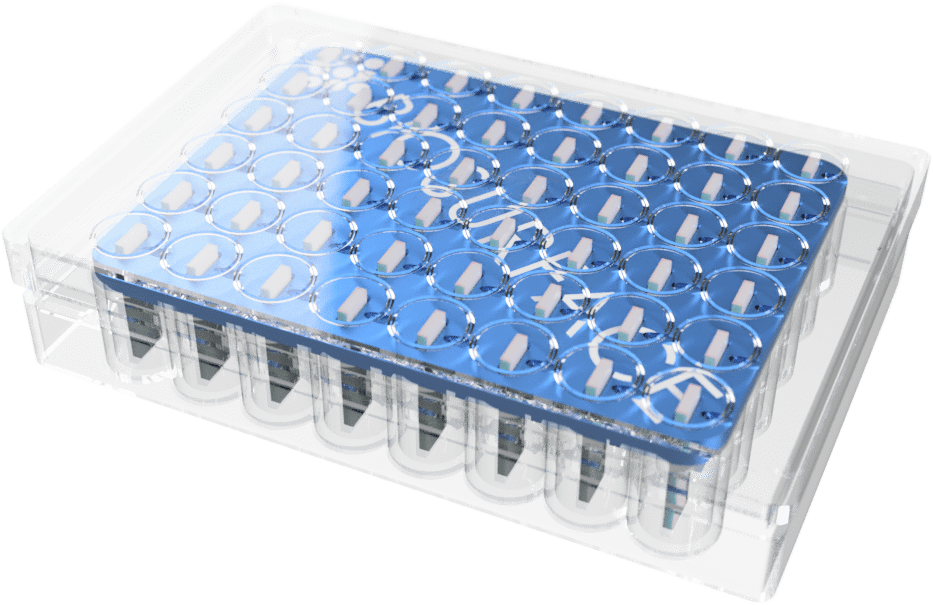MicroWell™ Biofilm Plate Assay
Revolutionizing Biofilm Research with Versatile Coupon Compatibility
The MicroWell™ Biofilm Plate Assay is the latest innovation from BioSurface Technologies, designed to expand the horizons of biofilm research. Engineered for precision and versatility, this anodized aluminum plate fits perfectly on a 48-well microtiter plate, providing a robust platform for diverse biofilm studies.
Key Features and Benefits
The MicroWell™ Biofilm Plate Assay holds 48 coupons, each measuring 0.25 inches by 0.80 inches, inside the wells. This versatility allows researchers to choose from a wide variety of materials, including custom options upon request, to tailor their studies to specific needs. This capability significantly enhances the scope of biofilm research by enabling studies on various surfaces and materials.
Sterility and convenience are at the forefront of the MicroWell™ assay’s design. The system utilizes the disposable lid that comes with 48-well plates, fitting securely over the coupon holder plate to prevent contamination during incubation. Additionally, the anodized aluminum plate is fully autoclavable, allowing for the reuse of the system. This feature not only ensures long-term reliability but also promotes cost-efficiency and environmental sustainability by reducing the need for disposable components.
Designed to facilitate biofilm assays similar to the Calgary Biofilm Device using ASTM E2799, the MicroWell™ system offers expanded material choices, enabling more comprehensive and diverse biofilm studies. Researchers can now conduct more varied and intricate experiments, assessing biofilm formation and behavior on various substrates. This broad range of applications makes the MicroWell™ Biofilm Plate Assay an essential tool for advancing biofilm research across multiple disciplines.
Discover how the MicroWell™ Biofilm Plate Assay can enhance your biofilm research. Join the many researchers who trust BioSurface Technologies to deliver reliable and cutting-edge biofilm research solutions. Contact us today for more information or to request a custom material option.

MicroWell™ Biofilm Plate Assay on Alignment Plate
To align the coupon height in each of the 48 wells, the anodized aluminum alignment plate is used. It can be fine-tuned to perfectly match the required coupon height inside the wells, and both plates are fully autoclavable, allowing sterilization of the plate and coupons prior to your experiment.
Applications
The MicroWell™ Biofilm Plate Assay is ideal for a wide range of biofilm research applications, including antimicrobial testing, material compatibility studies, and custom biofilm assays. By evaluating the efficacy of antimicrobial agents against biofilms formed on various materials, researchers can develop better strategies for managing and preventing biofilm-related issues. Material compatibility studies enable the investigation of how different surfaces influence biofilm formation and behavior, providing insights crucial for industries such as healthcare, food processing, and water treatment. Furthermore, the ability to design and conduct biofilm studies using custom materials tailored to specific research needs ensures that the MicroWell™ system can meet the unique requirements of any biofilm research project.

MicroWell™ Biofilm Plate Assay on 48-Well Microtiter Plate
The MicroPlate™ Biofilm Assay System is designed to perfectly fit a standard 48-well microtiter plate. This image demonstrates how it fits, and the coupons can be seen almost flush with the bottom of each of the wells.
Why Choose MicroWell™ Biofilm Plate Assay ?
With its versatile material compatibility, robust construction, and user-friendly design, the MicroWell™ Biofilm Plate Assay is a valuable addition to any biofilm research laboratory. Whether you are conducting standard biofilm assays or exploring new research frontiers, the MicroWell™ system provides the flexibility and reliability you need to achieve accurate and meaningful results. Its seamless integration with standard 48-well microtiter plates ensures that it can easily be incorporated into existing workflows and protocols, maximizing efficiency and minimizing disruption to ongoing research projects.


